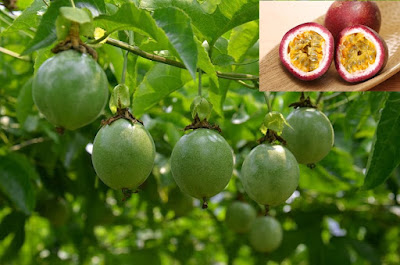Many people think that passion fruit and monk fruit are the same kind of fruit but have different names. In fact, they are two very different types of fruit, though they look the same. Passion fruit tastes sour while monk fruit is sweeter.
1. Essential difference between Passion Fruit and Monk Fruit
Passion Fruit: Passiflora edulis in scientific name, is a semi-woody vine species of passion flower, the Passiflora family. Native to southern Brazil through Paraguay and northern Argentina, it is now cultivated commercially in tropical and subtropical areas for its sweet, seedy fruit.
Monk Fruit(Luo Han Guo): It is the fruit of the cucurbitaceous plant Luo Han Guo, a perennial climbing vine, the tender stems are covered with white pilose and red glandular hairs, and the stems are dark purple with longitudinal ribs.
2. Distinguishing by leaves
Passion fruit: The leaves of passion fruit have a very strange phenomenon. The newly grown leaves are oval, and become palm-shaped (trilobed) as they grow into old leaves.
Monk fruit: leaves alternate, ovate or long ovate, green on the top, pubescent, densely distributed along the veins, dark green below; the tender leaves are dark brown-red, densely covered with red glandular hairs, densely pubescent along the veins.
3. Difference in flowers
Passion fruit: The round flowers look like the face of the sun, and the silky petals look like the rays of the sun, very gorgeous! Dioecious flowers, female flowers bear fruit, and male flowers are used for pollination.
Monk fruit: dioecious, inflorescence stalk, flower stalk, sepals, petals are all pilose and glandular hairs, florescence from June to August.
4. Difference in fruits
Passion fruit: egg shape, green when it is young, dark purple when it is ripe, generally sold in the market are fresh fruits, can be eaten fresh, can also be processed juice, jam, fruit wine, the taste is sweet and sour, and the fragrance is overflowing!
Monk fruit: Wong fruit is round, oblong or obovate, dark brown-red when young, green when mature, and hairy (dried fruits are mostly brown-black-brown). Generally, dried fruits are sold in the market. Both dried fruits and fresh fruits are mostly used for soaking in boiling water or making soup, and the taste is sweet.
5. Difference in efficacy
Passion fruit: Passion fruit has a complex effect on the central nervous system. It is a natural tranquilizer with relaxing and calming effects; it can treat insomnia, induce natural fall asleep and deep sleep, eliminate headaches, dizziness and other phenomena; it can also soothe Anxiety, nervousness, depression, headache, stomach pain, frequent urination, palpitation, muscle cramps, convulsions, pain and other discomforts caused by nervous tension.
Monk fruit: It has the effects of clearing heat and cooling blood, promoting body fluid and relieving cough, smoothing intestines and detoxification, rejuvenating skin, moisturizing lungs and resolving phlegm. Diabetes and irritability.
6. The difference in eating Passion and Monk fruits
How to eat passion fruit:
①Direct fresh food: split the passion fruit, scoop out the flesh with a spoon and eat it directly (the seeds are edible, rich in high-grade protein and high-grade fat).
②To make juice: Take a passion fruit, cut it open, scoop the pulp into a cup with a spoon, add 200ml of water, add a little sugar to adjust the sweetness, and stir to get a cup of nutritious juice with good color, aroma and taste. If you use a juicer to mix for a few seconds, the effect is better. Use ice water in summer, warm water in winter, and add a few drops of honey for better flavor. In addition, because the density of the fruit pulp contained in passion fruit juice is different from that of natural super fiber, it is a normal physical phenomenon that stratification occurs after being prepared and left for a period of time, and it has no effect on the quality.
③ Make tea: In addition to its calming effect, passion fruit also helps to improve sleep quality. Drinking a cup of tea made from it before going to bed every night can also help you fall asleep.
④ Honey lemon passion fruit juice: Take three passion fruits, about 200ml of cold water, a little honey, a little lemon juice, and a little crushed ice. Then wash and cut the passion fruit, dig out the pulp with a spoon, put it in the juicer, add honey, cold water, lemon juice, beat well and filter, pour it into a cup, add crushed ice and drink. Has the effect of lowering blood pressure.
⑤ Brewing wine, brewing tea or cooking dishes: In addition to extracting pectin, medicinal ingredients and processed feed, the fruit shell can also be used for brewing wine or tea, and cooking dishes.
How to eat monk fruit:
①Candy drink: crush monk fruit, add water and decoct it for 3 times, fry for half an hour each time, steam over low heat to remove moisture to make it viscous, let cool, mix in white sugar, mix well, and dry , Crushed and bottled for later use. Take about 10 grams each time to make a drink with boiling water.
② Momordica grosvenori beverage: Wash and crush Momordica grosvenori, wash the hawthorn, and put it in the pot with Momordica grosvenori. Add clean water to the pot. After the heat is cooked, remove the residue and pour the juice into the cup. Put an appropriate amount of honey into the cup, stir well, and drink it as a summer drink. Can lose weight and fitness.
③ Monk fruit japonica rice porridge: crush monk fruit, add appropriate amount of water to boil, cook for 3 times, filter out the residue with gauze and set aside. Wash the japonica rice with water and add it to the monk fruit soup to cook the porridge. When the porridge is boiling, transfer to a low heat and continue to cook until the rice is rotten. Add salt and monosodium glutamate to eat.











